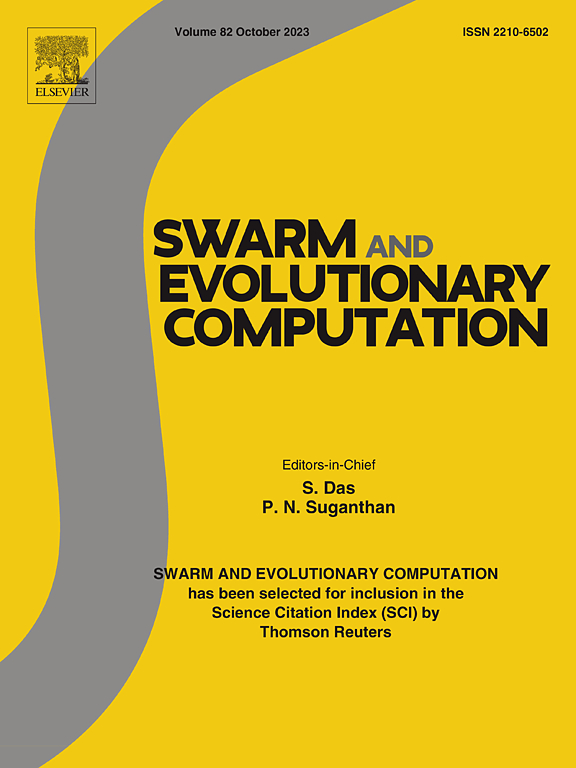Constrained multi-objective particle swarm optimization for bistatic RFID network planning with distributed antennas
IF 8.5
1区 计算机科学
Q1 COMPUTER SCIENCE, ARTIFICIAL INTELLIGENCE
引用次数: 0
Abstract
Radio Frequency Identification (RFID) network planning (RNP) is crucial for optimizing network performance by setting system parameters. The new bistatic RFID architecture with a distributed antenna system (DAS) offers advantages for the passive Internet of Things (IoT). It separates transmission and reception to minimize self-interference and extend uplink communication range, while using distributed antennas for broader coverage. Bistatic DAS RNP differs from monostatic in various aspects. Monostatic RNP focuses on factors like reader number, location, and power, while bistatic DAS RNP involves more parameters, including antenna and device numbers, locations, and interconnections. Coverage and interference are more complex, and practical planning faces constraints on antenna ports and feeder line length. Consequently, bistatic DAS RFID network planning (BDRNP) problems are novel, complex, high-dimensional, and constrained, making them relatively unexplored and highly challenging. This paper analyzes bistatic DAS RFID network coverage and interference, and proposes a mathematical model for BDRNP problems. A modified multi-objective discrete particle optimization (M2DPSO) algorithm is introduced, incorporating a modified k-means clustering method to group antennas, which ensures satisfaction constraints and reduces decision variable dimensionality from to to where is the problem size. Redundant SDRs/carrier emitters are dynamically eliminated based on global best solution set changes. Experimental results show that M2DPSO algorithm significantly outperforms three existing popular algorithms – nondominated sorting genetic algorithm II (NSGAII), discrete particle swarm optimization (DPSO), and multi-objective evolutionary algorithm based on decomposition (MOEAD) – by 265%, 361%, and 726% respectively, in average inverted generational distance (IGD) metrics.
分布式天线双基地RFID网络规划约束多目标粒子群算法
无线射频识别(RFID)网络规划(RNP)是通过设置系统参数来优化网络性能的关键。采用分布式天线系统(DAS)的新型双基地RFID架构为无源物联网(IoT)提供了优势。它将发射和接收分离,以最大限度地减少自干扰并扩展上行通信范围,同时使用分布式天线以扩大覆盖范围。双稳态DAS RNP在许多方面与单稳态不同。单站RNP主要考虑读卡器数量、位置和功率等因素,而双站DAS RNP涉及更多参数,包括天线和设备数量、位置和互连。覆盖和干扰更为复杂,实际规划面临天线端口和馈线长度的限制。因此,双基地DAS RFID网络规划(BDRNP)问题是新颖、复杂、高维和受限的,使它们相对未被探索和高度具有挑战性。本文分析了双基地DAS RFID网络的覆盖和干扰,提出了BDRNP问题的数学模型。提出了一种改进的多目标离散粒子优化(M2DPSO)算法,采用改进的k-means聚类方法对天线进行分组,保证了满足约束条件,并将决策变量维数从4|CS|+|CS|2降至4|CS|至4|CS|,其中|CS|为问题大小。基于全局最优解集的变化动态消除冗余的sdr /载波发射器。实验结果表明,M2DPSO算法在平均逆代距离(IGD)指标上分别显著优于非支配排序遗传算法II (NSGAII)、离散粒子群优化算法(DPSO)和基于分解的多目标进化算法(MOEAD),分别高出265%、361%和726%。
本文章由计算机程序翻译,如有差异,请以英文原文为准。
求助全文
约1分钟内获得全文
求助全文
来源期刊

Swarm and Evolutionary Computation
COMPUTER SCIENCE, ARTIFICIAL INTELLIGENCEC-COMPUTER SCIENCE, THEORY & METHODS
CiteScore
16.00
自引率
12.00%
发文量
169
期刊介绍:
Swarm and Evolutionary Computation is a pioneering peer-reviewed journal focused on the latest research and advancements in nature-inspired intelligent computation using swarm and evolutionary algorithms. It covers theoretical, experimental, and practical aspects of these paradigms and their hybrids, promoting interdisciplinary research. The journal prioritizes the publication of high-quality, original articles that push the boundaries of evolutionary computation and swarm intelligence. Additionally, it welcomes survey papers on current topics and novel applications. Topics of interest include but are not limited to: Genetic Algorithms, and Genetic Programming, Evolution Strategies, and Evolutionary Programming, Differential Evolution, Artificial Immune Systems, Particle Swarms, Ant Colony, Bacterial Foraging, Artificial Bees, Fireflies Algorithm, Harmony Search, Artificial Life, Digital Organisms, Estimation of Distribution Algorithms, Stochastic Diffusion Search, Quantum Computing, Nano Computing, Membrane Computing, Human-centric Computing, Hybridization of Algorithms, Memetic Computing, Autonomic Computing, Self-organizing systems, Combinatorial, Discrete, Binary, Constrained, Multi-objective, Multi-modal, Dynamic, and Large-scale Optimization.
 求助内容:
求助内容: 应助结果提醒方式:
应助结果提醒方式:


